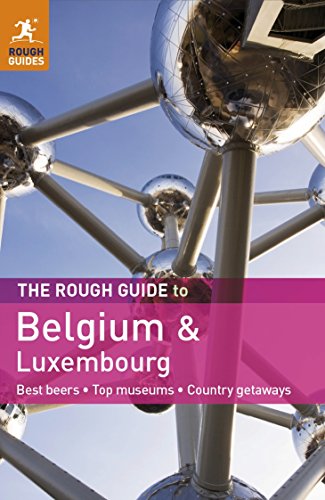Items related to The Rough Guide to Belgium & Luxembourg (Rough...

"synopsis" may belong to another edition of this title.
Belgium divides between the Flemish (Dutch-speaking) north of the country, known as Flanders, and French-speaking Wallonia in the south. There’s more to this divide than just language, though: the north and south of the country are visually very different. The north, made up of the provinces of West and East Flanders, Antwerp, Limburg and the top half of Brabant, is mainly flat, with a landscape and architecture not unlike the Netherlands. Antwerp is the largest city here, a sprawling, bustling old port with doses of high fashion and high art in roughly equal measure. Further west, in Flanders, are the great Belgian medieval cloth towns of Bruges and Ghent, with a stunning concentration of Flemish art and architecture. Bruges in particular is the country’s biggest tourist pull, and although this inevitably means it gets very crowded, you shouldn’t miss it on any account. Beyond lies the Belgian coast, which makes valiant attempts to compete with the seaside resorts of the rest of Europe but is ultimately let down by the coldness of the North Sea. Nonetheless, there are a couple of appealing seaside resorts, most notably De Haan, and the beaches and duney interludes along the coast are delightful. But you might be better off spending time in some of the other inland Flanders towns, not least Ieper, formerly and better known as Ypres, where every year visitors come to reflect on the stark sights of the nearby World War I battlefields and vast, sad acreages of cemeteries.
Marking the meeting of the Flemish and Walloon parts of Belgium, Brussels, the capital, is more exciting and varied than its reputation as a bland Euro-capital would suggest. Central enough to be pretty much unavoidable, it’s moreover useful as a base for day-trips, especially given that Belgium isn’t a large country and has an excellent public transport system. Bruges and Ghent are easily accessible from here, as is the old university city of Leuven to the east, and the cathedral city of Mechelen, halfway to Antwerp.
Flemish Brabant encircles Brussels, but to the south of the capital it narrows into a slender corridor beyond which lies Wallonian Brabant, distinguished by the splendid church at Nivelles and the elegaic abbey ruins at nearby Villers-la-Ville. West of here, the Walloon province of Hainaut is mostly agricultural country, dotted with industrial centres like Charleroi and the more appealing Mons, but also home to the handsome old town of Tournai. East of here lies Belgium’s most scenically rewarding region, the Ardennes, spread across the three provinces of Namur, Liège and Luxembourg. This is an area of deep, wooded valleys and heathy plateaux, often very wild and excellent for hiking, cycling and canoeing. Use either Namur or Luxembourg City as a jumping-off point for the heart of the region, at St-Hubert, Bouillon or La Roche-en-Ardenne.
The Ardennes reaches across the Belgian border into the northern part of the Grand Duchy of Luxembourg, a green landscape of high hills and wooded ravines topped with crumbling castles overlooking rushing rivers. The two best centres for touring the countryside are the quiet little towns of Vianden and Echternach, featuring an extravagantly picturesque castle and a splendid abbey respectively. Indeed, despite its feeble reputation, the Duchy – or rather its northern reaches – packs more scenic highlights into its tight borders than many other more renowned holiday spots, and is perfect for hiking and, at a pinch, mountain-biking. The Ardennes fizzles out as you reach the plainer scenery of the south, where the rolling agricultural terrain of the Gutland is a pleasant preamble to Luxembourg City, whose bastions and bulwarks recall the days when this was one of the strongest fortresses in Europe.
WHEN TO GO
Belgium enjoys a fairly standard temperate climate, with warm, if mild, summers and moderately cold winters. Generally speaking, temperatures rise the further south you go, with Wallonia a couple of degrees warmer than Flanders for most of the year, though in the east this is offset by the more severe climate of continental Europe, and emphasized by the increase in altitude of the Ardennes. Luxembourg, too, has more extreme temperatures and harsher winters, often accompanied by snow. In both countries rain is always a possibility, and you can expect a greater degree of precipitation in the Ardennes and upland regions than on the northern plains.
The cities of Belgium and Luxembourg are all-year tourist destinations, though you might think twice about visiting Bruges, the region’s most popular spot, during August, when things get mighty crowded. Flanders as a whole is best visited any time between early spring and late autumn, though winter time has its advantages too – iced canals and hoarfrost polders – if you don’t mind the short hours of daylight. Wallonia, especially the Ardennes, is more seasonal, with many things closing down in the winter, so try to visit between April and October.
"About this title" may belong to another edition of this title.
- PublisherRough Guides
- Publication date2011
- ISBN 10 1848367201
- ISBN 13 9781848367203
- BindingPaperback
- Edition number5
- Number of pages392
- Rating
Buy New
Learn more about this copy
Shipping:
US$ 4.13
Within U.S.A.
Top Search Results from the AbeBooks Marketplace
THE ROUGH GUIDE TO BELGIUM & LUX
Book Description Condition: New. New. In shrink wrap. Looks like an interesting title! 0.9. Seller Inventory # Q-1848367201

